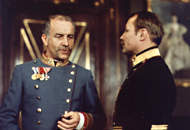Adele/Bonadea
Our discussion of Adele Bloch-Bauer offered widely differing perceptions of her character, physicality, and surroundings. Klimt's portrait can be seen in various dualities, and these pairs of opposing characteristics are provocative since the very nature of Austria as a country during this time is described in our readings as indistinct, shadowy, and uncertain.
Bonadea is described as capable of "angelic expression" and her bearing is "maternally sensuous," yet she is also "anxious." Ulrich notes that "the soft snowfall she was diffusing inside the cab had grown thicker": so she is alternately engaged with Ulrich and then seemingly indifferent to him in only a few minutes. Musil's description of Bonadea presents a woman who may be a young mother unfulfilled with her comfortable life, a Freudian hysterical housewife trapped in one of the "bourgeois marriages...arranged as if they were first and foremost business mergers" described in the Janik/Toulmin reading. The character seems to be both conscious of her steps toward an affair and resigned to the chance meeting, both aggressive agent and unwitting participant as she declines to give him her name yet returns later to initiate their liaison.
Both women could be construed as anxious; Musil describes Bonadea as such and Adele's hands could indicate a fidgety constitution. They could both be in loveless marriages and surrounded by material comfort. They both seem resigned to a fate, and tired. Bonadea may or may not recognize a brilliant man (she thinks Ulrich may be in the cab, then thinks he has a head injury), yet Adele certainly would - her intelligence is palpable. Adele looks to me as if she would be more certain about her opinions and action than Bonadea would. Each woman evinces many contradictions. Are they doppelgangers? Not quite. Archetypes of bourgeois women in this place during this time? Yes.



No comments:
Post a Comment